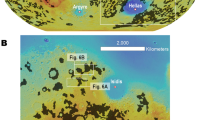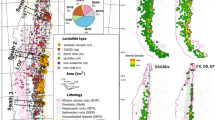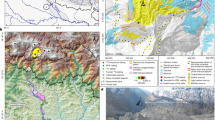Abstract
Distinctive landscapes termed ‘washboard’ and ‘fluted’ terrains1,2, which border the N2 ice plains of Sputnik Planitia along its northwest margin, are among the most enigmatic landforms yet seen on Pluto. These terrains consist of parallel to sub-parallel ridges that display a remarkably consistent east-northeast–west-southwest orientation—a configuration that does not readily point to a simple analogous terrestrial or planetary process or landform. Here, we report on mapping and analysis of their morphometry and distribution as a means to determine their origin. Based on their occurrence in generally low-elevation, low-relief settings adjacent to Sputnik Planitia that coincide with a major tectonic system, and through comparison with fields of sublimation pits seen in southern Sputnik Planitia, we conclude that washboard and fluted terrains represent crustal debris that were buoyant in pitted glacial N2 ice that formerly covered this area, and which were deposited after the N2 ice receded via sublimation. Crater surface age estimates indicate that this N2 ice glaciation formed and disappeared early in Pluto’s history, soon after formation of the Sputnik Planitia basin. These terrains constitute an entirely new category of glacial landform.
This is a preview of subscription content, access via your institution
Access options
Access Nature and 54 other Nature Portfolio journals
Get Nature+, our best-value online-access subscription
$29.99 / 30 days
cancel any time
Subscribe to this journal
Receive 12 digital issues and online access to articles
$119.00 per year
only $9.92 per issue
Buy this article
- Purchase on Springer Link
- Instant access to full article PDF
Prices may be subject to local taxes which are calculated during checkout




Similar content being viewed by others
Data availability
The data that support the findings of this study are available from the corresponding author upon reasonable request.
References
Moore, J. M. et al. The geology of Pluto and Charon through the eyes of New Horizons. Science 351, 1284–1293 (2016).
Howard, A. D. et al. Present and past glaciation on Pluto. Icarus 287, 287–300 (2017).
Schenk, P. M. et al. Basins, fractures and volcanoes: global cartography and topography of Pluto from New Horizons. Icarus 314, 400–433 (2018).
Schmitt, B. et al. Physical state and distribution of materials at the surface of Pluto from New Horizons LEISA imaging spectrometer. Icarus 287, 229–260 (2017).
Greenstreet, S. et al. Impact and cratering rates onto Pluto. Icarus 258, 267–288 (2015).
Bertrand, T. et al. The nitrogen cycles on Pluto over seasonal and astronomical timescales. Icarus 309, 277–296 (2018).
Bertrand, T. & Forget, F. Observed glacier and volatile distribution on Pluto from atmosphere-topography processes. Nature 540, 86–89 (2016).
Earle, A. M. et al. Long-term surface temperature modeling of Pluto. Icarus 287, 37–46 (2017).
Keane, J. T. et al. Reorientation and faulting of Pluto due to volatile loading within Sputnik Planitia. Nature 540, 90–93 (2016).
White, O. L. et al. Geological mapping of Sputnik Planitia on Pluto. Icarus 287, 261–286 (2017).
Moore, J. M. et al. Sublimation as a landform-shaping process on Pluto. Icarus 287, 320–333 (2017).
Stern, S. A. et al. Past epochs of significantly higher pressure atmospheres on Pluto. Icarus 287, 47–53 (2017).
Wei, Q. et al. Young surface of Pluto’s Sputnik Planitia caused by viscous relaxation. Astrophys. J. Lett. 856, L14 (2018).
Gladstone, G. R. et al. The atmosphere of Pluto as observed by New Horizons. Science 351, aad8866 (2016).
Grundy, W. M. et al. Surface compositions across Pluto and Charon. Science 351, aad9189 (2016).
Grundy, W. M. et al. Pluto’s haze as a surface material. Icarus 314, 232–245 (2018).
Buratti, B. J. et al. Global albedos of Pluto and Charon from LORRI New Horizons observations. Icarus 287, 207–217 (2017).
Moore, J. M. et al. Bladed terrain on Pluto: possible origins and evolution. Icarus 300, 129–144 (2018).
Robbins, S. J. et al. Craters of the Pluto–Charon system. Icarus 287, 187–206 (2017).
Crater Analysis Techniques Working Group. Standard techniques for presentation and analysis of crater size–frequency data. Icarus 37, 467–474 (1979).
Singer, K. N. et al. Craters on Pluto and Charon—surface ages and impactor populations. In Proc. 47th Lunar and Planetary Science Conference 2310 (LPI, 2016).
Nimmo, F. et al. Reorientation of Sputnik Planitia implies a subsurface ocean on Pluto. Nature 540, 94–96 (2016).
Matsuyama, I. & Nimmo, F. Tectonic patterns on reoriented and despun planetary bodies. Icarus 195, 459–473 (2008).
Matthes, F. E. Ablation of snow-fields at high altitudes by radiant solar heat. Trans. Am. Geophys. Union 15, 380–385 (1934).
Lliboutry, L. The origin of penitents. J. Glaciol. 2, 331–338 (1954).
Amstutz, G. C. On the formation of snow penitentes. J. Glaciol. 3, 304–311 (1958).
Moores, J. E. et al. Penitentes as the origin of the bladed terrain of Tartarus Dorsa on Pluto. Nature 541, 188–190 (2017).
Acknowledgements
This work was supported by NASA’s New Horizons project.
Author information
Authors and Affiliations
Consortia
Contributions
O.L.W. performed the mapping that is the basis of the research and wrote the majority of the main text, as well as the ‘Factors affecting ridge mapping’ and ‘Surface albedo, colour and composition’ sections of the Methods. J.M.M., A.D.H. and W.B.M. aided O.L.W. in interpretation of the mapping and morphometric analysis, and editing of the manuscript. J.T.K. quantitatively compared the washboard mapping results with TPW simulations (Supplementary Fig. 6) and provided much of the text in the ‘Do washboard ridges record a palaeopole?’ section of the Methods. K.N.S. provided much of the text in the ‘Crater density-based terrain age estimates’ section of the Methods, as well as editing the manuscript. T.B. provided text discussing climatological considerations of the glaciation hypothesis for WFT, as well as editing the manuscript. S.J.R. provided the pixel scale, solar incidence angle and emission angle maps in Supplementary Fig. 2b–d, as well as editing the manuscript. P.M.S. provided the topography data used in the mapping and analysis (including the DEM shown in Fig. 2b and Supplementary Fig. 1) and associated text. B.S. provided the composition maps in Supplementary Fig. 1c–f and associated text. B.J.B. provided the normal reflectance map in Supplementary Fig. 1b. Per New Horizons team requirements, the New Horizons Science Team principal investigator (S.A.S.) and four project scientists (K.E., C.B.O., H.A.W. and L.A.Y.) must be included as co-authors on all peer-reviewed papers authored by New Horizons team members and affiliates. All authors approved the final version of the manuscript.
Corresponding author
Ethics declarations
Competing interests
The authors declare no competing interests.
Additional information
Publisher’s note: Springer Nature remains neutral with regard to jurisdictional claims in published maps and institutional affiliations.
Supplementary information
Supplementary Information
Supplementary Figures 1–7
Rights and permissions
About this article
Cite this article
White, O.L., Moore, J.M., Howard, A.D. et al. Washboard and fluted terrains on Pluto as evidence for ancient glaciation. Nat Astron 3, 62–68 (2019). https://doi.org/10.1038/s41550-018-0592-z
Received:
Accepted:
Published:
Issue Date:
DOI: https://doi.org/10.1038/s41550-018-0592-z
This article is cited by
-
Large-scale cryovolcanic resurfacing on Pluto
Nature Communications (2022)



